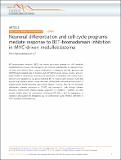Neuronal differentiation and cell-cycle programs mediate response to BET-bromodomain inhibition in MYC-driven medulloblastoma
Author(s)
Bandopadhayay, Pratiti; Piccioni, Federica; O’Rourke, Ryan; Ho, Patricia; Gonzalez, Elizabeth M.; Buchan, Graham; Qian, Kenin; Gionet, Gabrielle; Girard, Emily; Coxon, Margo; Rees, Matthew G.; Brenan, Lisa; Dubois, Frank; Shapira, Ofer; Greenwald, Noah F.; Pages, Melanie; Balboni Iniguez, Amanda; Paolella, Brenton R.; Meng, Alice; Sinai, Claire; Roti, Giovanni; Dharia, Neekesh V.; Creech, Amanda; Tanenbaum, Benjamin; Khadka, Prasidda; Tracy, Adam; Tiv, Hong L.; Hong, Andrew L.; Coy, Shannon; Rashid, Rumana; Lin, Jia-Ren; Cowley, Glenn S.; Lam, Fred Chiu-Lai; Goodale, Amy; Lee, Yenarae; Schoolcraft, Kathleen; Vazquez, Francisca; Hahn, William C.; Tsherniak, Aviad; Bradner, James E.; Yaffe, Michael B; Milde, Till; Pfister, Stefan M.; Qi, Jun; Schenone, Monica; Carr, Steven A.; Ligon, Keith L.; Kieran, Mark W.; Santagata, Sandro; Olson, James M.; Gokhale, Prafulla C.; Jaffe, Jacob D.; Root, David E.; Stegmaier, Kimberly; Johannessen, Cory M.; Beroukhim, Rameen; ... Show more Show less
DownloadPublished version (1.816Mb)
Publisher with Creative Commons License
Publisher with Creative Commons License
Creative Commons Attribution
Terms of use
Metadata
Show full item recordAbstract
BET-bromodomain inhibition (BETi) has shown pre-clinical promise for MYC-amplified medulloblastoma. However, the mechanisms for its action, and ultimately for resistance, have not been fully defined. Here, using a combination of expression profiling, genome-scale CRISPR/Cas9-mediated loss of function and ORF/cDNA driven rescue screens, and cell-based models of spontaneous resistance, we identify bHLH/homeobox transcription factors and cell-cycle regulators as key genes mediating BETi’s response and resistance. Cells that acquire drug tolerance exhibit a more neuronally differentiated cell-state and expression of lineage-specific bHLH/homeobox transcription factors. However, they do not terminally differentiate, maintain expression of CCND2, and continue to cycle through S-phase. Moreover, CDK4/CDK6 inhibition delays acquisition of resistance. Therefore, our data provide insights about the mechanisms underlying BETi effects and the appearance of resistance and support the therapeutic use of combined cell-cycle inhibitors with BETi in MYC-amplified medulloblastoma.
Date issued
2019-06Department
Koch Institute for Integrative Cancer Research at MITJournal
Nature Communications
Publisher
Springer Science and Business Media LLC
Citation
Bandopadhayay, P. et al. "Neuronal differentiation and cell-cycle programs mediate response to BET-bromodomain inhibition in MYC-driven medulloblastoma." Nature Communications 10, 1 (June 2019): 2400 © 2019 The Author(s)
Version: Final published version
ISSN
2041-1723